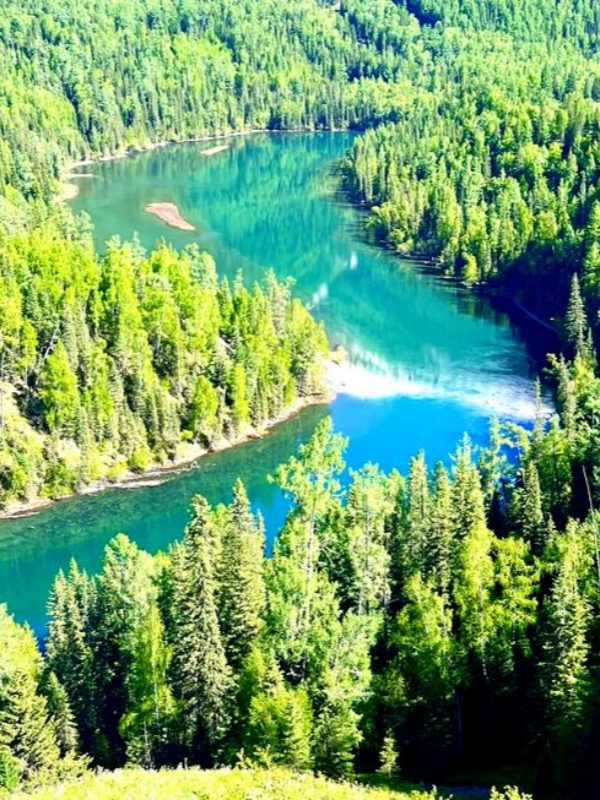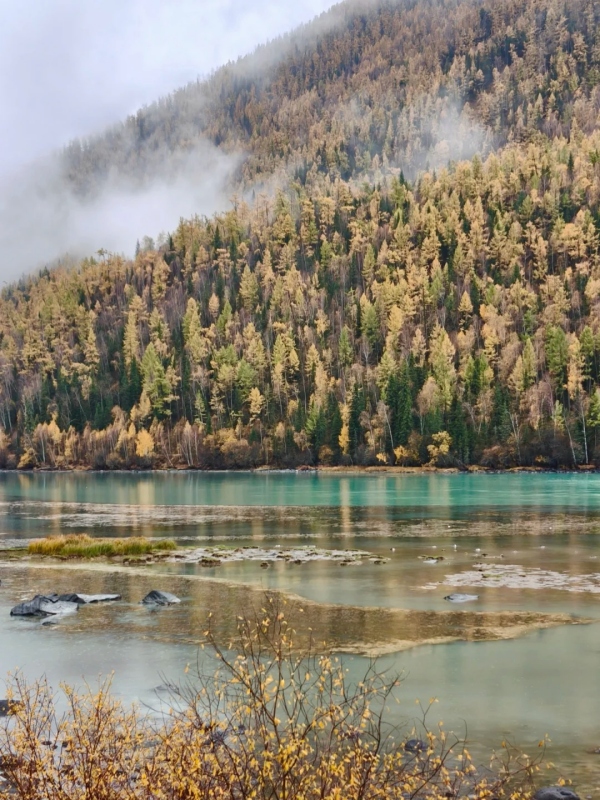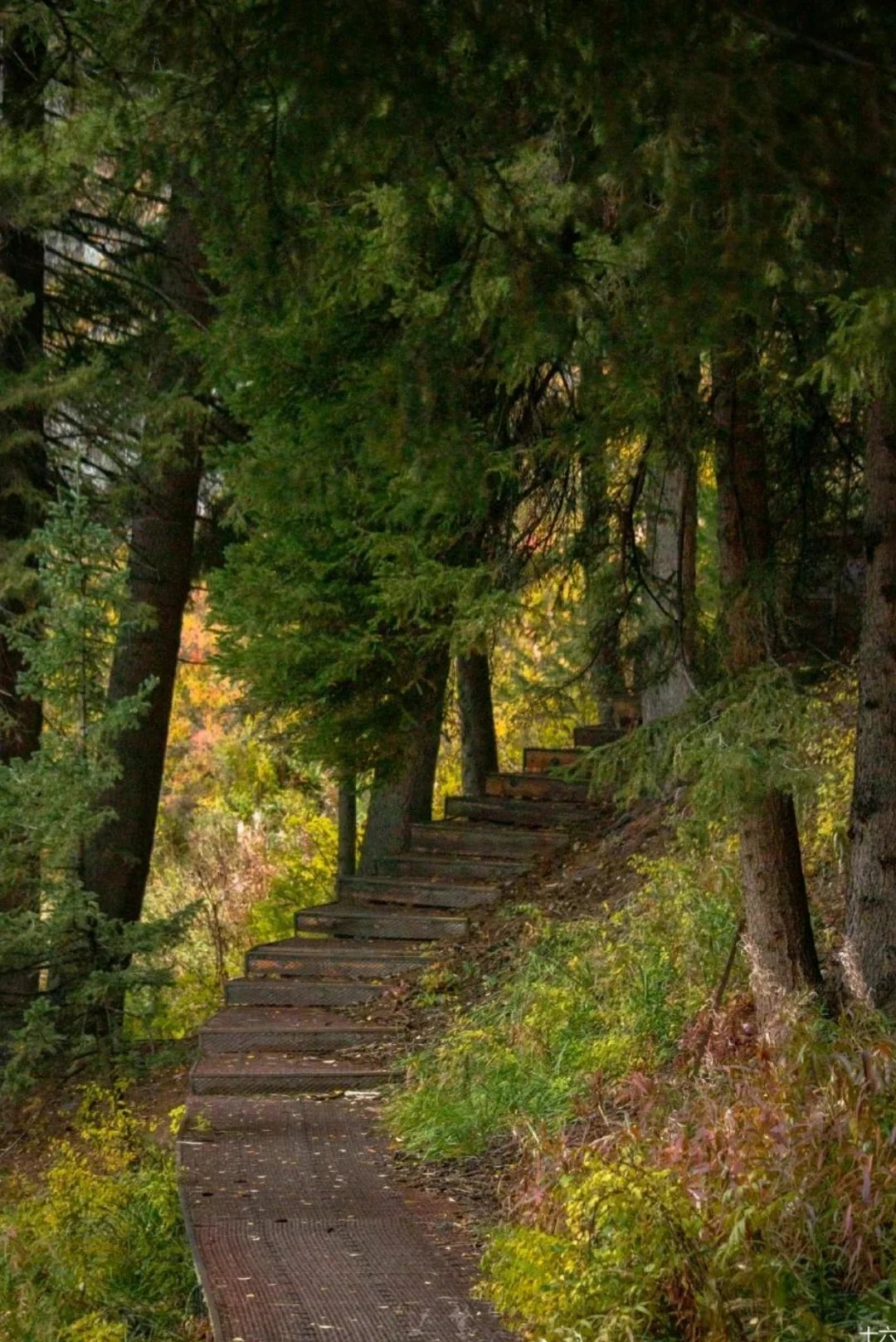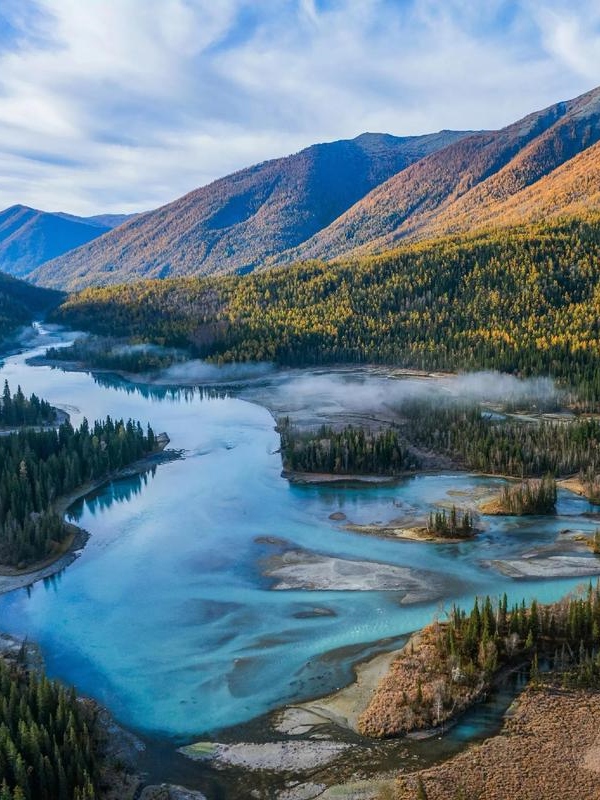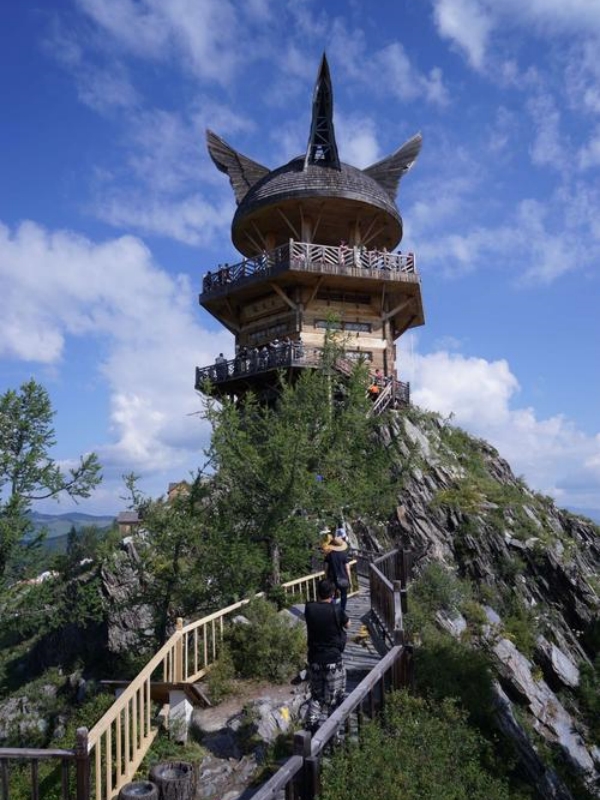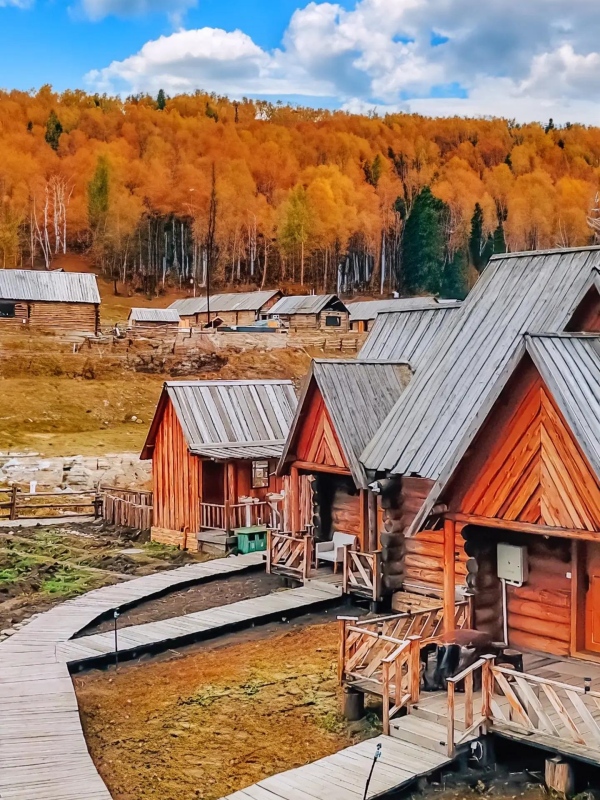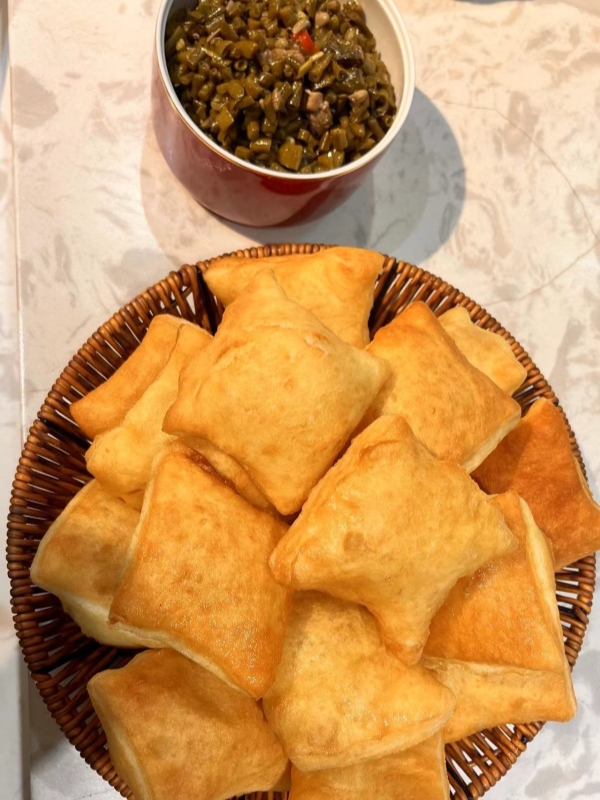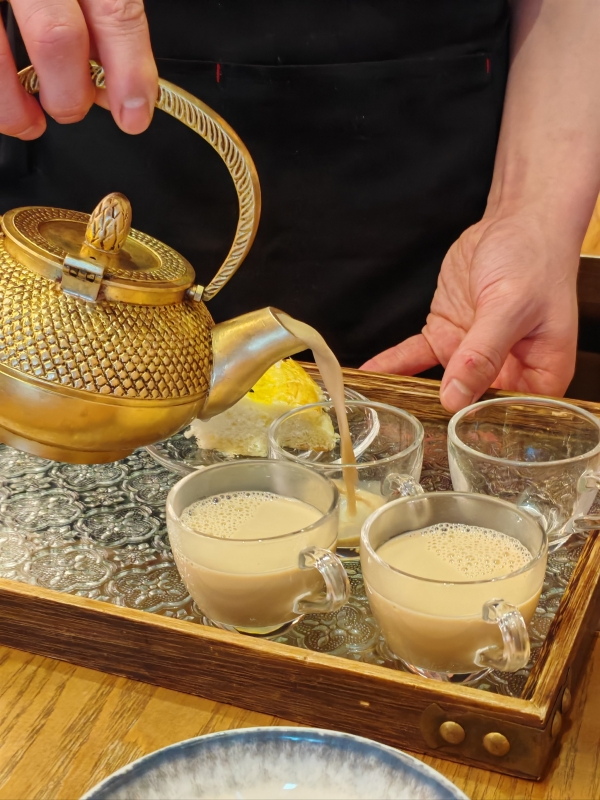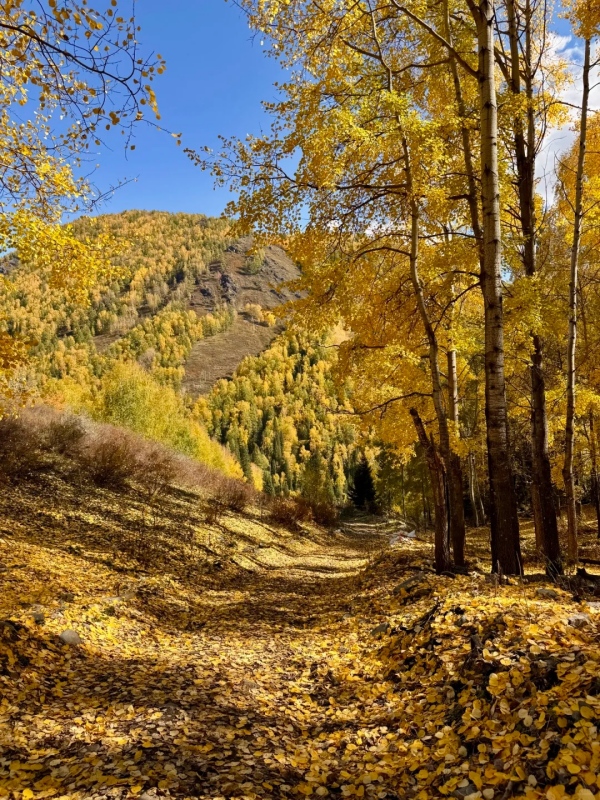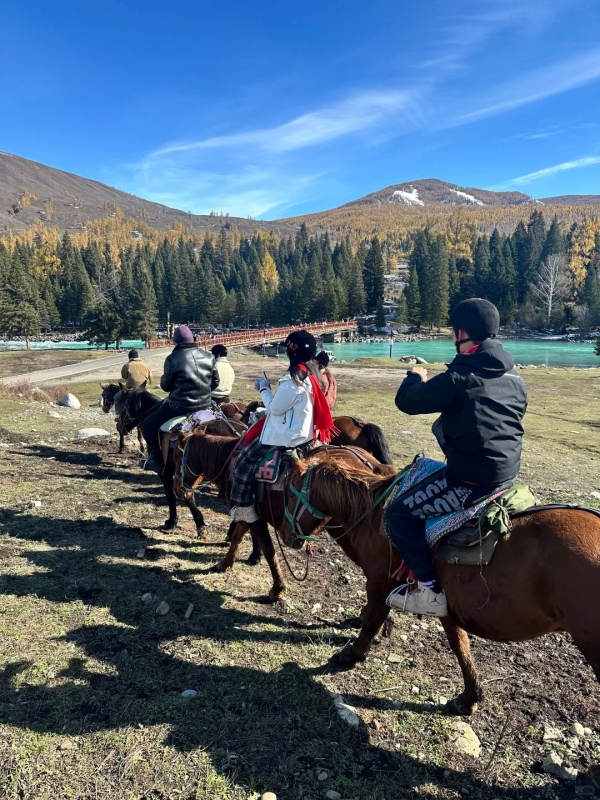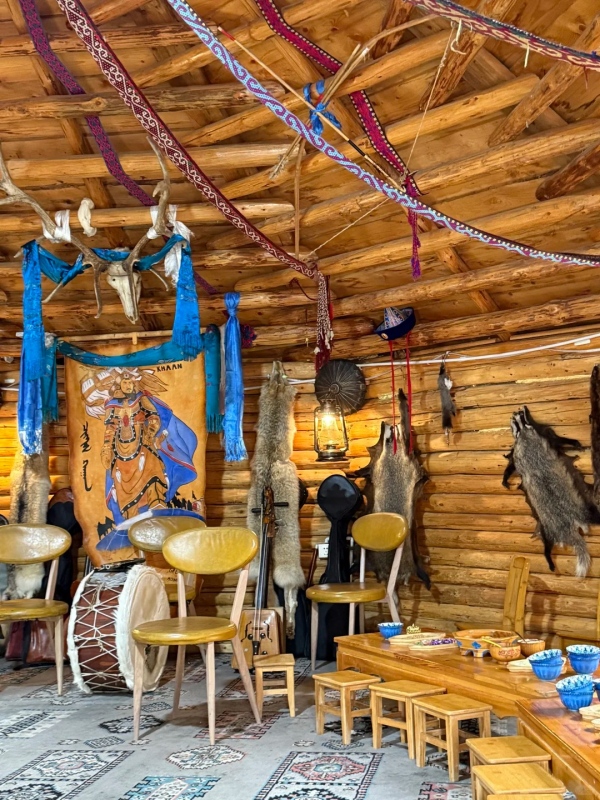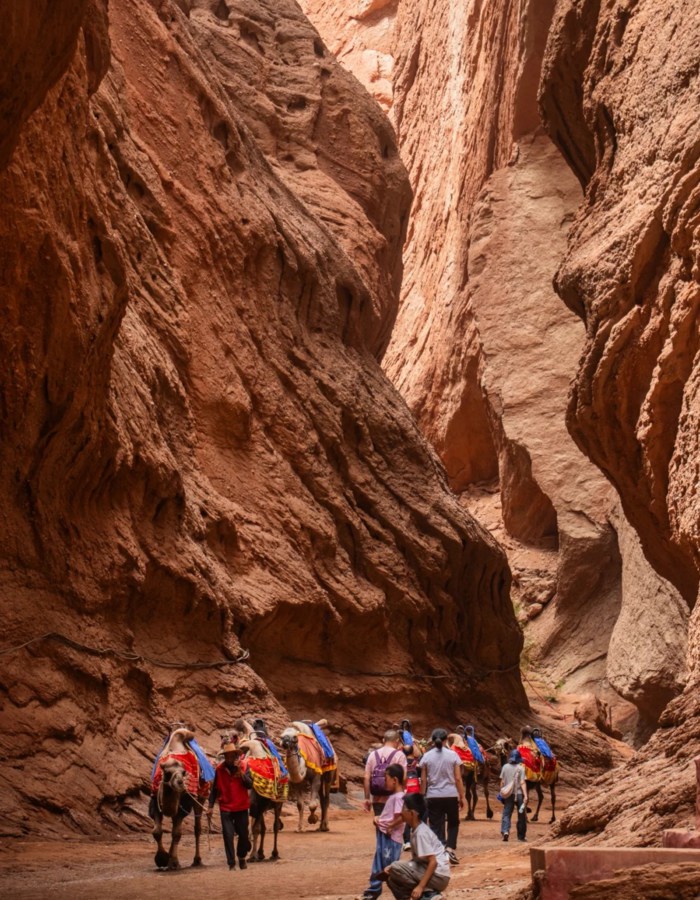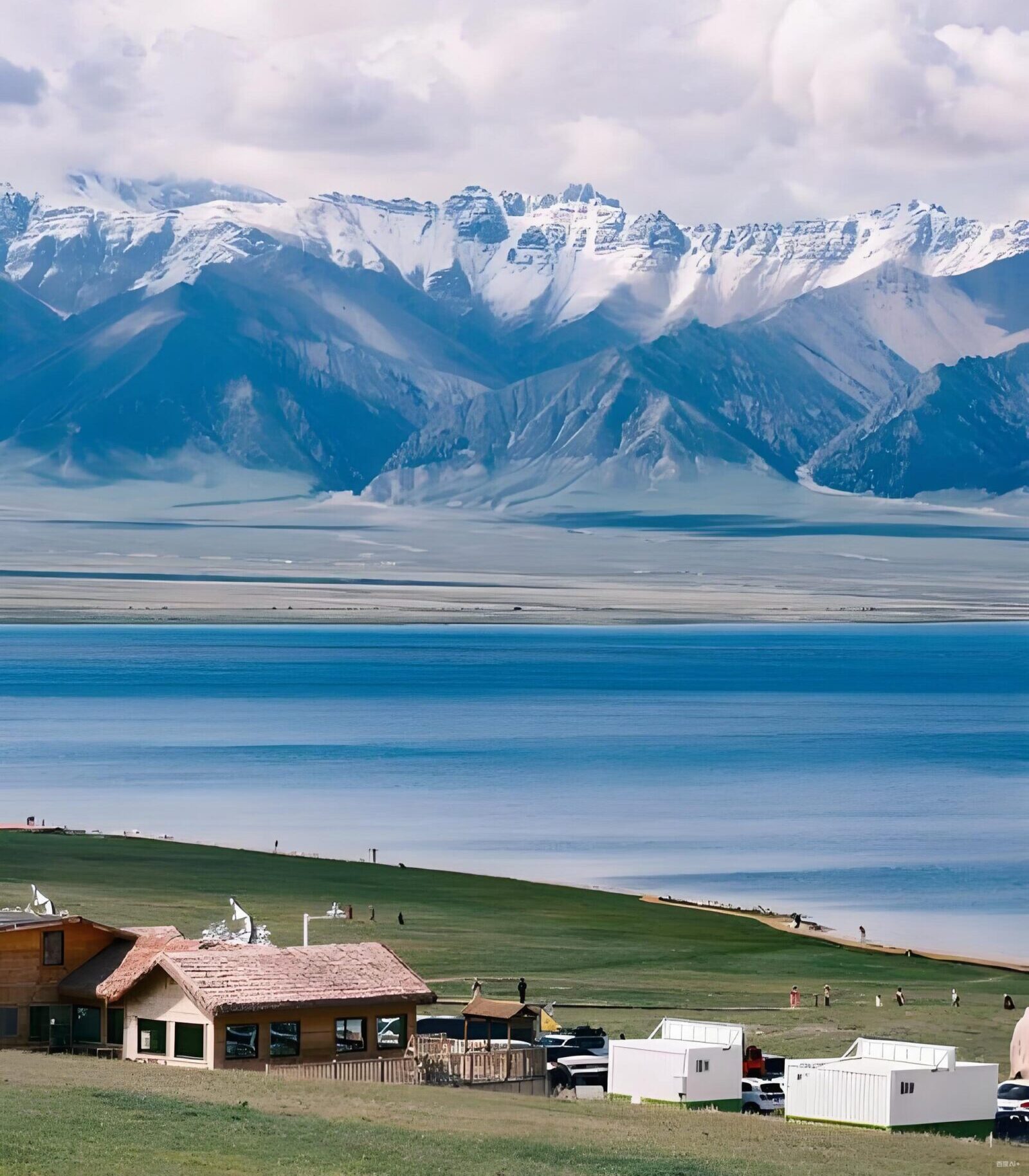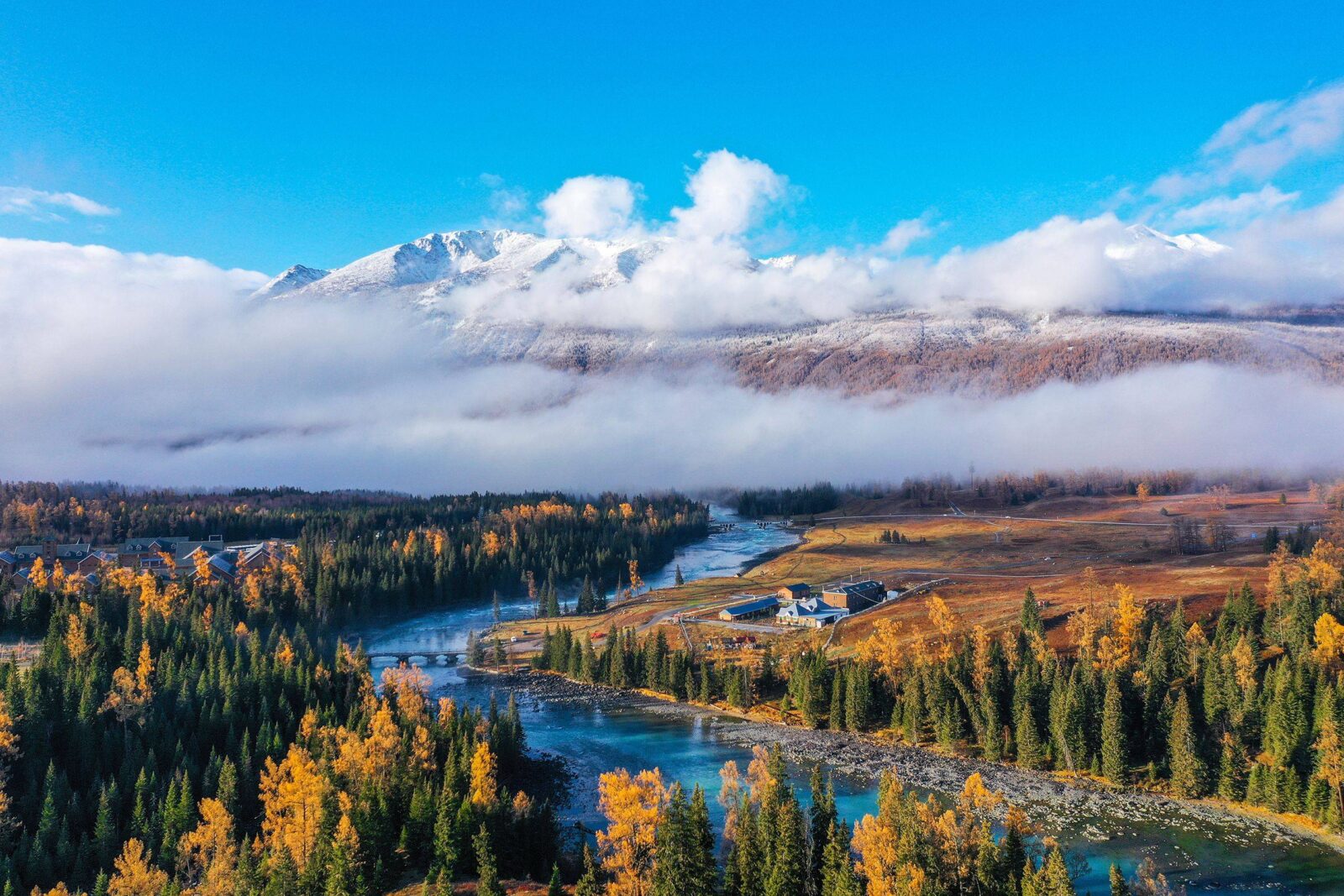
Xinjiang Kanas National Geopark
Lying way up in the far north of Xinjiang lies the Xinjiang Kanas National Geopark, a vast alpine area of turquoise lakes, dense Siberian taiga and far-flung Tuva villages that keep intact their centuries-old lifestyle nomadism. Famous for its everchanging colour Kanas Lake and stunning glacial valleys, the park is at the point where China, Mongolia, Kazakhstan and Russia meet, producing a scenery and culture that is unique in the country. With excellent mountain air, clear rivers and wooden cabins surrounded by birch forests, it is a place where nature and tradition co-exist in their most primitive forms.
So here we go – if you’re thinking of making a tome to the Xinjiang Kanas National Geopark this guide is just what you need. We’ll tell you what to see, what to eat, how to get about and the tricks of the locals which they don’t tell you about. Think sunrise at Hemu Village, mist over the Fairy Bay, and a tranquillity that makes you forget that there is indeed a mobile phone signal. Whether you’re adding to the golden autumn leaves, want to taste genuine Tuva food, or just want to get away from things for a few days – stick around – your Kanas saga is about to begin.
Kanas at a Glance: Essential Facts
Before diving into the details, here's everything you need to know about Xinjiang Kanas National Geopark at a glance. This quick reference covers the practical essentials and cultural highlights that define this remarkable destination.
| Category | Key Details |
|---|---|
| 🏔️ Official Name | Xinjiang Kanas National Geopark (新疆喀纳斯国家地质公园) |
| 📍 Location | Burqin County, Altay Prefecture, Northern Xinjiang — 700km from Urumqi, 150km from Burqin |
| 🎫 Tickets | ¥230 (1-day + shuttle) / ¥270 (2-day); Combo ¥195 (Kanas + Hemu + Baihaba); Fish Pavilion +¥120 |
| 🕓 Hours | 08:00–20:00 (peak) / 09:00–19:00 (off-season) |
| 🌲 Highlights | Deepest glacial lake in China (188.5m); only Siberian taiga forest in China; elevation 1,374–2,030m |
| 👥 Tuva Culture | Nomadic Mongolian tribe; log cabins, herding life, shamanic customs, unique language |
| 📸 Top Spots | Three Bays (Fairy, Moon, Wolong), Kanas Lake, Hemu Village, Fish Pavilion (360° view) |
| 🍽️ Local Food | Cold-water fish hotpot ¥180, hand-pulled lamb ¥80–120, Baursak & milk tea ¥5–10 |
| 🎯 Activities | Three Bays hike (2.7km), horseback ride to Beautiful Peak ¥200, Tuva family visit ¥100–150 |
| 👤 Ideal For | Photographers (Sept–Oct colors), nature & culture lovers, hikers, adventure travelers |
| ⚠️ Notes | No private cars (shuttle only); Baihaba needs border pass ¥20–50; weak mobile signal; bring ¥1,000+ cash; altitude 1,300–2,000m |
These basics give you the framework. Now let's explore what makes this geopark truly special—and why it earned UNESCO recognition.
Kanas: China's Glacial Gem of Taiga and Tuva Heritage
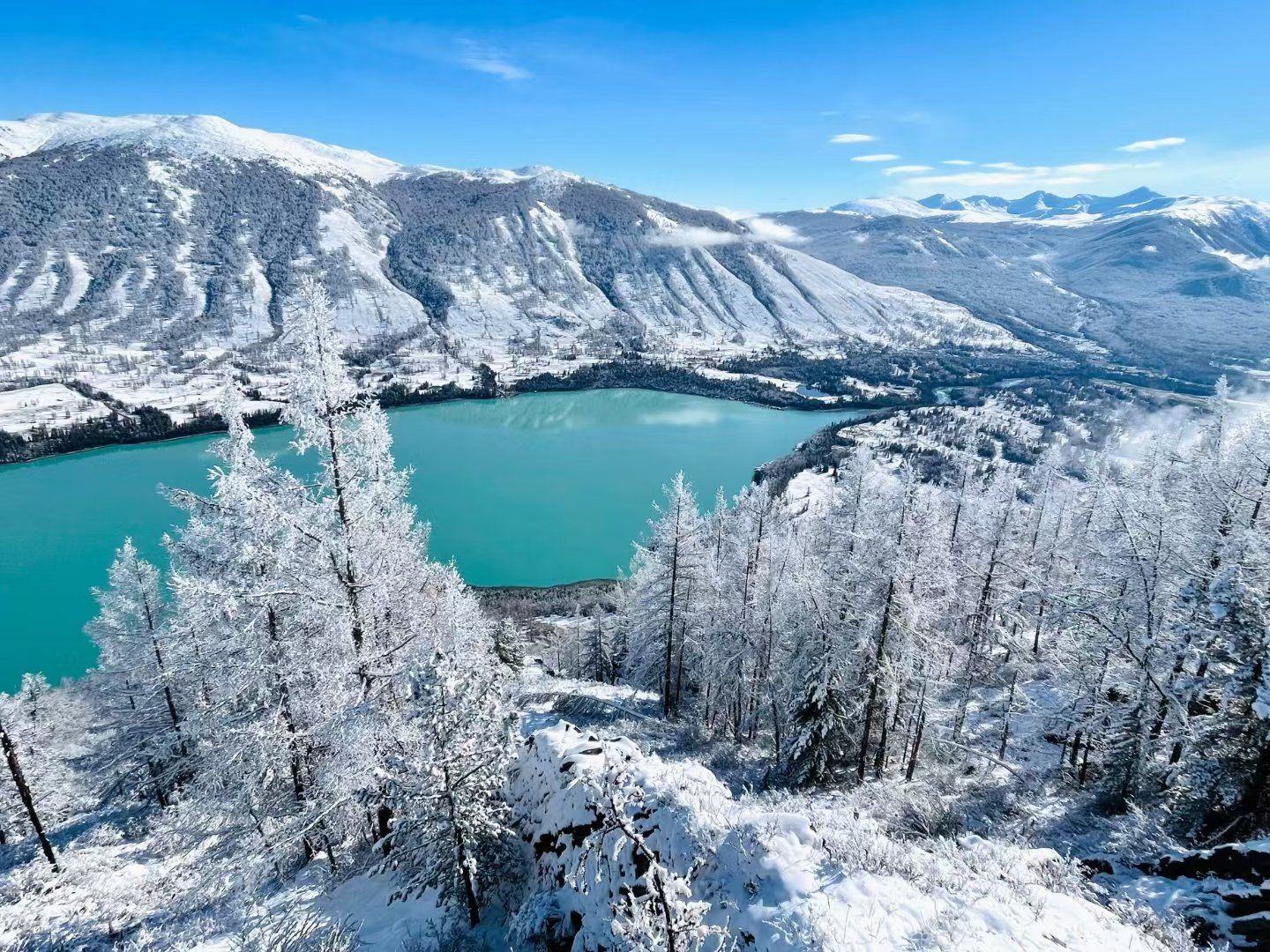
Winter of Kanas
Geological Wonder of Kanas: Where Ice Shaped an Emerald World
A natural wonder rather than another scenic spot is the Xinjiang Kanas National Geopark. The Kanas Lake, which is China’s deepest glacial barrier lake, formed by glacial movement 200000 years ago, has a maximum depth of 188.5 meters. It covers an area of 45.73 square km and has a water volume of 5.38 billion cubic meters. The Lake is nestled amidst the majestic Altai Mountains at a height of 1270 metres.
Kanas is the only place in China with Siberian taiga forests which include towering larch, Siberian fir and Korean pine trees. Imagine a bit of Switzerland hurling down into Mongolia producing just this sort of result. Brown bears, lynx, and it may be noted here with delight, lazy Hucho taimens hiding away in the depths of the lake may all make up the park's ecosystem.
If Kanas was carved by ice, Shangri-La answers with water and light in Potatso National Park Yunnan.
Culture and Colors of Kanas Lake: The Tuva Spirit and Shifting Shades
This region is home to the last settlements of the Tuva people, who still practice the nomadic life of centuries gone by. Their log cabin architecture—designed for the bitter winters—is scattered throughout the land like that of a Tolkien novel. Walk through the village of Hemu at dawn, watch the smoke rise from the chimneys while herdsmen guide their horses through the morning mists, and you will have the feeling of living in another era.
Then there is the raising of color phenomenon of the lake. The "color-changing lake" is no myth, but a reality of science. It is the glacial minerals, mostly, calcium carbonates, that reflect different wavelengths through the day. Morning? Emerald green. Noon? Turquoise. Sunset? Milky jade. I visited in late September. The lake would be turquoise blue, and then the clouds would come and it would be grayish green. Within thirty minutes, the sun would burst out and it would be sapphire. It's great! !
Now that you know what makes Kanas, let us look at its sights: the must see places that commemorate these wonders.
Top Attractions: From Turquoise Lakes to Mountain Peaks
Fairy Bay (The Morning Mist Theatre): When the Valley Turns into a Dream
Best Time: 6:30-8:00am for the morning mist spectacle
The "fairy" effect occurs when chilly air at dawn meets warmer lake water, creating a mist blanket over the shallow marshes. I came at 7 a.m. on a chilly September day. The mist was so thick that log cabins in the river appeared and vanished like ghosts. Pure magic--but lasted only 40 minutes before the sun burned it off. If heavens reflection is waiting for it at Tianchi Lake, Fairy Bay was like a dream wrapped in mist.
Photography Tips: Use a telephoto lens to capture the layered mist. Arrive before tour groups (before 8am) for peaceful shots.
Reality Check: Rain eliminates the mist (requires clear skies + large day-night temperature difference). After October, extreme cold reduces fog occurrence.
Moon Bay (The Instagram Star): Catch the Perfect Curve Before the Crowds Do
This S-shaped river bend features two crescent-shaped sandbars locals call "fairy footprints" from Genghis Khan legend. The best viewpoint? The observation platform between 8-10am when side lighting creates the most dramatic shadows. I went at 7:30am—had it to myself for 20 minutes.
Insider Tip: Arrive before 8am or after 5pm. Mid-morning to afternoon, tour groups swarm the platform (capacity: 50 people). For photography, use a polarizing filter to reduce water glare and enhance the turquoise tones.
Wolong Bay (The Hidden Dragon): The Calm Corner of the Kanas River
Named for the dragon-shaped sandbar in the river's center, Wolong Bay offers a different kind of beauty—more serene, less crowded. The sandbar appears as a green dragon in summer, transforming to golden scales in autumn.
Insider Tip: Skip the viewing platform crowds—walk the 2.7km wooden boardwalk from Fairy Bay to Wolong Bay. Zero vehicles, just birdsong and rustling aspens. My favorite Kanas moment.
The Three Bays are just the appetizer. The main course? Kanas Lake itself.
Kanas Lake: China’s Deepest Mystery and Its Shape-Shifting Colors
At 1,374 meters elevation and plunging to 188.5 meters deep, Kanas Lake dominates the landscape. The lake monster legend—possibly giant Hucho taimen fish—adds mystique, but the real attraction is the water itself. That color-changing phenomenon creates a living painting that never repeats.
Two Ways to Experience It:

This 2-hour walk is criminally underrated. You'll see ancient rock paintings, glacial traces, and possibly red squirrels. Best part? Almost zero tourists. The trail weaves through old-growth forest with constant lake views.

TripAdvisor reviews are mixed (3.5 stars). The boat is small, crowded during peak season, and you don't see much more than from shore. Save your ¥120.
After chasing Kanas’s shifting hues, find their final reflection at Sailimu Lake.
Fish Viewing Pavilion: Climb for the Ultimate 360° Kanas View
The Stats: 2,030m elevation, 600m vertical climb, 1,068 steps, 1-1.5 hours
Worth It?


I climbed at 4pm—golden hour lighting, fewer crowds. Bring trekking poles and water. The view IS stunning, but only if weather cooperates. Check forecast before buying ticket.
Hemu Village: Step Into a Tuva Storybook Frozen in Time
Called "China's Most Beautiful Village," Hemu preserves authentic Tuva culture in log cabin architecture and nomadic traditions.
Don't Miss: Hadeng Platform sunrise at 6am. Wake at 5:30am, climb 20 minutes to the platform. At 6am, sunrise paints log cabins golden while chimney smoke curls into mist. This alone justifies visiting Kanas.
Wooden Cabin Stay (¥300-500/night): Authentic but basic—shared bathrooms, no heating. Bring a sleeping bag after September. But waking to horses neighing and experiencing genuine Tuva hospitality makes the rustic conditions worthwhile.
Cultural Experience: Try a family visit (¥100-150) for traditional foods, herding stories, and cultural insights. Cultural etiquette: Remove shoes before entering homes, don't step on thresholds, receive food with both hands, don't touch hunting rifles on walls (sacred items).
After soaking in these breathtaking sights, you'll need to refuel. Luckily, Kanas offers flavors as unique as its landscapes.
Local Flavors: Tuva & Kazakh Cuisine to Try (Ranked by Local Popularity)
- Cold-Water Fish
- Baursak
- Milk Tea
A day of hiking Three Bays and climbing Fish Pavilion works up quite the appetite. Kanas's food scene blends Tuva traditions with Kazakh nomadic cooking—hearty, flavorful, and unlike anything you'll taste elsewhere in China.
1.Cold-Water Fish Hotpot (冷水鱼火锅) ⭐⭐⭐⭐⭐
What Makes It Special: Wild Coregonus peled from Kanas Lake, firm texture, sweet broth. Add skin-belt noodles to soak up the soup.
Where: Lao Yufu (Kanas Village, ¥180/serves 2-3) or Hemu Fish Restaurant (¥200/serves 2-3, fresher).
The fish is so fresh, it almost doesn't need seasoning. The broth alone could make plain noodles taste like heaven. Just don't order in low season (Nov-May)—it's farmed fish, not worth it.
2.Hand-grabbed lamb (手抓肉) ⭐⭐⭐⭐
Preparation: Fresh lamb boiled in plain water, preserving original flavor. Eat with hands, paired with onions and salt. A traditional Tuva hospitality dish (¥80-120/serving).
I tried it at a Tuva family's home in Hemu. The mutton was so tender, it fell off the bone. No gamey smell—just pure lamb flavor. Pair with nang bread to soak up juices.
3.Baursak + Milk Tea (包尔萨克 + 奶茶) ⭐⭐⭐
Kazakh fried dough pastries (crispy, slightly sweet) with salty milk tea. Costs just ¥5-10 at roadside stalls. Tuva hosts always serve this combo. The salty tea seems weird at first, but after a cold morning hike, it's oddly comforting. Dip baursak in wild blueberry jam—perfection.
4.Fermented Mare's Milk (马奶子酒) ⭐⭐
5-8% alcohol, sour-sweet taste, grassland celebration staple. It's an acquired taste—think slightly boozy kefir. Worth trying once for the cultural experience, but I wouldn't order a second glass.
Beyond eating, Kanas offers hands-on experiences that immerse you in its nomadic culture and wild landscapes.
Unique Experiences: How to Feel Kanas, Not Just See It
- Birch Forests
- Horseback Riding
- Inner of Tuva Family
Viewing Kanas from observation decks is one thing. Truly experiencing it requires getting your hands dirty—or your boots muddy. Here are the activities that transform tourists into travelers.
Hiking the Three Bays Trail: Follow the Birch Path to Serenity
Distance: 2.7km (Fairy Bay → Wolong Bay)
Difficulty: Easy (flat wooden boardwalk)
Duration: 1.5-2 hours (including photo stops)
Best Season: Sept 20-Oct 10 (peak autumn colors)
The boardwalk hugs the Kanas River, weaving through birch and larch forests. In autumn, golden leaves carpet the path. You'll cross small wooden bridges, hear the river gurgling below, and possibly spot squirrels darting up trees.
I walked this trail at 7am in late September. The low-angle sunlight filtered through golden birches, creating a cathedral-like effect. Zero tourists for the first hour—just me, the river, and occasional bird calls. Easily my favorite Kanas memory.
Practical Tips:
Depart before 8am (avoid tour groups)✅
Bring water (no refill points en route)✅
Slippery after rain—wear non-slip shoes❌
Horseback Riding to Beautiful Peak: Ride Through Meadows and Mountain Air
Departure: Hemu Village
Distance: ~12km round trip
Duration: 2 hours (including rest)
Price: ¥200 (includes guide)
The trail winds through white birch forests and alpine meadows. Your Tuva guide (usually a herder) leads at a gentle pace—perfect for beginners. At Beautiful Peak's base, you'll get panoramic views of Hemu Village nestled in the valley.
My guide, a 60-year-old Tuva man, shared stories about herding reindeer in winter. He pointed out medicinal herbs his grandmother used. This cultural exchange was more valuable than the scenery.
Safety Notes: Horses are trained, but follow guide instructions. Wear long pants (legs may get sore). After September, mornings/evenings are cold—dress warmly.
Tuva Family Visit: Share Tea, Stories, and Genuine Hospitality
Experience Includes:
- Traditional foods (hand-pulled lamb, milk tea, baursak)
- Cultural stories (nomadic history, Tuva language, folk customs)
- Handicraft demonstrations (felt-making, wood carving)
Booking: Arrange through guesthouse hosts in Hemu/Kanas Village (¥100-150/person including meal)
Cultural Etiquette (Professional Insight):
Remove shoes before entering homes✅
Don't step on thresholds (considered disrespectful)✅
Accept food with both hands✅
Don't touch rifles on walls (sacred items)❌
The host family's grandmother, 78, spoke only Tuva. Through a translator, she explained how they smoke horse sausage for winter. We sat on felt cushions around a low table, drinking endless cups of salty milk tea. It felt like stepping into another century.
When to Visit: Decoding Kanas's Seasons
Kanas wears different faces throughout the year. Choose wrong, and you'll miss the mist at Fairy Bay or face unbearable crowds. Here's how each season delivers—and disappoints.
Season-by-Season Breakdown
| Season | Temperature | Landscape Features | Advantages | Disadvantages | Best For |
|---|---|---|---|---|---|
| 🍂 Autumn (Sept 20-Oct 10) | Day: 15°C, Night: 5°C | 🍁 Golden birch forests, five-color mountain layers, bluest lake waters | ✅ Photography paradise, stable weather, most beautiful scenery | ❌ Prices double, massive crowds, book 2 months ahead | 📸 Photographers, first-time visitors, budget-flexible travelers |
| 🌿 Summer (June-Aug) | Day: 25°C, Night: 15°C | 🌸 Lush greenery, wildflower blooms, active wildlife | ✅ Cool & comfortable, hiking-friendly, reasonable prices | ❌ Occasional rain, more mosquitoes, less dramatic colors | 🥾 Heat escapees, hiking enthusiasts, family trips |
| ❄️ Winter (Dec-Feb) | Day: -10°C, Night: -30°C | ❄️ Snow wonderland, rime frost spectacle, frozen lake walkable | ✅ Fewest tourists, lowest prices, unique experiences | ❌ Extreme cold, limited facilities, transport restrictions | ⛷️ Skiers, adventure seekers, photography enthusiasts |
| 🌱 Spring (April-May) | Day: 10°C, Night: 0°C | 🌼 Snow melting, new greenery emerging, high waterfall volume | ✅ Very few tourists, budget-friendly | ❌ Bland scenery, unstable weather, some facilities closed | 🌄 Budget travelers, solitude seekers |
The Golden Window: Sept 20 - Oct 5
Why These 15 Days Are Perfect:
- Peak Colors: Birch forests turn golden (chlorophyll breakdown reveals carotenoids). Mountain layers show five-color gradients due to elevation-based timing differences.
- Stable Weather: 80%+ sunny days, highest probability of morning mist at Fairy Bay.
- Comfortable Temperatures: Daytime hiking pleasant (15-20°C), mornings/evenings cool but not extreme (5-10°C).
Critical Warning: I went Sept 25th—perfect. But friends who visited Oct 2nd (National Holiday) paid ¥800/night for a ¥300 guesthouse and queued 2 hours for shuttle buses. Avoid Oct 1-7 at all costs.
Practical Recommendation:
✅ Best Specific Dates: Sept 22-28 (90% peak colors, 60% normal crowds)
❌ Worst Dates: Oct 1-7 (200% crowds, 200% prices)
Now that you know WHEN to go, let's tackle HOW to plan—the logistics that make or break a Kanas trip.
Kanas isn't a "show up and wing it" destination. Remote location, limited infrastructure, and unpredictable mountain weather require smart planning. Here's everything I wish I'd known before my first visit.
Getting There: The Smartest Ways to Reach the Edge of China
| Transport | Time | Cost | Comfort | Rating | Details |
|---|---|---|---|---|---|
| ✈️ Direct Flight | 1.5h | ¥800-1500 | ⭐⭐⭐⭐⭐ | ⭐⭐⭐⭐⭐ | Urumqi → Kanas Airport, 1-2 daily flights, 1h drive to park entrance |
| 🚗 Self-Drive | 10-12h | ¥500 fuel | ⭐⭐⭐⭐ | ⭐⭐⭐⭐ | West route recommended, via Devil City & Rainbow Beach, flexible photo stops |
| 🚌 Bus | 15h+ | ¥300 | ⭐⭐ | ⭐⭐ | First to Burqin (8h), next day transfer (3h), exhausting time waste |
I flew. Worth every yuan—saved 2 vacation days and arrived fresh for sunrise hikes. If you have time, self-drive the west route (via Karamay). The Urho Ghost City and Rainbow Beach are stunning bonuses.
Where to Stay: From Cozy Cabins to Convenient Villages
Priority Ranking:
Hemu Village is the most recommended. You’ll get magical sunrise views, real Tuva cultural immersion, and far fewer tourists, though facilities are basic and rooms cost ¥300–800.
Kanas Village is convenient for attractions and offers more lodging choices, but prices jump to ¥500–1200 during peak season.
Jiadengyu is the budget-friendly option with better facilities and rates from ¥200–600, but daily park re-entry eats up time.
Burqin County suits quick transits. It’s the cheapest place (¥100–300) but lies about 150km away from Kanas.
I split my stay: 1 night in Hemu (for sunrise), 2 nights in Kanas Village (central access). Hemu's wooden cabin had no heating, but waking up to horses neighing and smoke curling from chimneys? Worth the cold.
Booking Advice:
- Autumn: Book 2 months ahead (Booking.com / Ctrip)
- Winter: Walk-in available (prices 50% off)
Top 5 Mistakes to Avoid: Don’t Let Small Things Ruin Big Views
❌ "One Day Is Enough" Myth
Reality: Just Three Bays + Kanas Lake takes 6 hours, plus queue times. One day = rushed overview. Minimum 2 days.
❌ Wearing New Shoes for Hiking
Result: Blisters ruin entire trip. Break in shoes 1 week before.
❌ Not Checking Weather Before Fairy Bay
Reality: Rain = no morning mist. Wasted trip. Check forecast before departing.
❌ Visiting on Weekends/National Holiday
Result: 2-hour queues, photo location fights, doubled prices.
❌ Relying on Mobile Payment
Reality: Mountain area has poor signal, Alipay often fails. Bring ¥1,000 cash.
Armed with these tips, you're ready to tackle the logistics. But questions always pop up—here are the most common ones.
FAQs About Xinjiang Kanas National Geopark: Everything You’re Still Wondering
Q: How many days do I need for Xinjiang Kanas National Geopark?
Two full days are the minimum to see the highlights. The park covers vast glacial valleys and alpine forests, so a rushed visit misses the real charm. Staying three days allows time for sunrise at Hemu Village and the Three Bays hike near Kanas Lake. If you plan to photograph sunsets or take horseback rides, adding an extra day makes the experience smoother.
Q: Can I really see the Kanas Lake Monster?
You probably won’t see it, but that’s part of the fun. Locals say huge Hucho taimen fish—sometimes over two meters—swim in the lake. Scientists think that’s the “monster.” Whether real or not, the mystery adds to the legend of Xinjiang Kanas National Geopark. Travelers often linger by the pier hoping to catch strange ripples on calm afternoons.
Q: Do I need a border pass for Baihaba?
Yes, a border pass is required since Baihaba sits near Kazakhstan. You can get it at Burqin Border Police Station for about ¥20 or at the Kanas Visitor Center for ¥50. The area is scenic, but if you’ve already seen Hemu, it may feel similar. Always carry your passport when applying and bring cash as card payments aren’t accepted.
Q: What’s the best way to see Fairy Bay’s morning mist?
Arrive early on a clear morning when temperatures shift sharply overnight. Catch the first shuttle at 6:30am to reach the viewing deck by sunrise. The mist forms when the Kanas River meets cold dawn air, a phenomenon unique to Xinjiang Kanas National Geopark. Many photographers recommend using a tripod since the mist shifts fast with wind.
Q: Will I get altitude sickness there?
Unlikely, though some travelers feel lightheaded. Elevation ranges between 1,300 and 2,030 meters. Staying hydrated and pacing yourself on hikes, especially climbing Fish Pavilion, helps. Locals suggest drinking warm tea or eating small snacks often to maintain energy.
Q: Can I drive my own car inside Xinjiang Kanas National Geopark?
No, private vehicles aren’t allowed to protect the fragile alpine environment. Visitors must park at Jiadengyu and use the official shuttle system. The routes are efficient, connecting Hemu, Kanas Village, and the scenic Three Bays without hassle. Expect shuttles every 15–20 minutes during peak season.
Q: Is winter Kanas worth visiting despite the cold?
Yes, but only if you’re prepared for freezing conditions. Temperatures can drop below -30°C, yet the snow-covered taiga and frozen lake are breathtaking. Winter offers serenity few places can match in Xinjiang Kanas National Geopark, though gear up properly. Most local guesthouses remain open but have limited heating, so book ahead.
Q: What does the ¥230 ticket for Xinjiang Kanas National Geopark include?
The ticket covers shuttles within the main park area, including the Three Bays and Kanas Lake routes. Extra fees apply for Fish Pavilion, Hemu, Baihaba, or boat rides. Expect total costs around ¥450 if exploring all major spots. Tickets can be booked on Ctrip or at the gate using WeChat Pay or Alipay.
